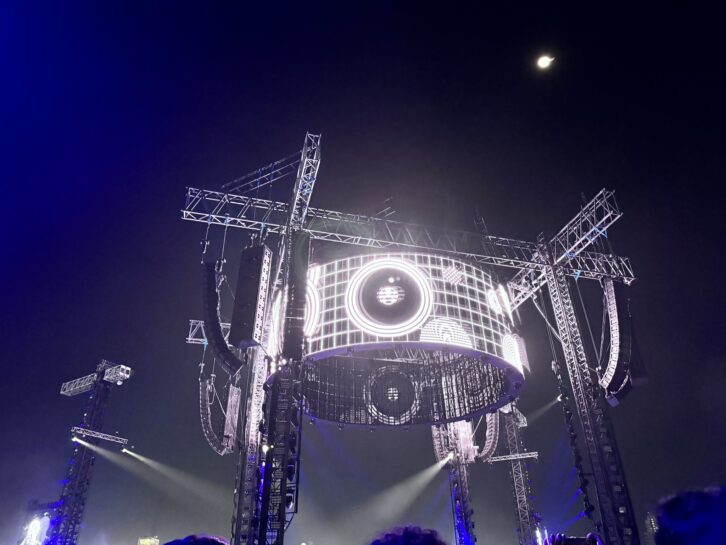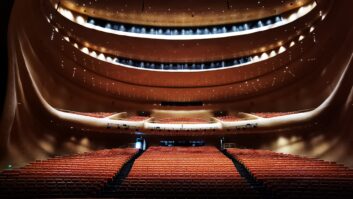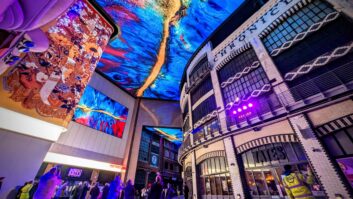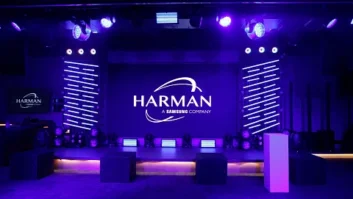A large deployment of PANTHER & LEOPARD line array systems from Meyer Sound powered a recent concert by English pop superstar Ed Sheeran, in Mumbai, India, as part of his global +-=÷x Tour, i.e. “The Mathematics Tour”.
Phoenix Networks planned the deployment of the Meyer Sound system inventory with the aim of creating a stereo sonic effect to match the scale of the stage design. The 360-degree circular stage, which rotated on its axis, ensured views of Sheeran from every corner of the venue, while a giant circular ‘HALO screen’ positioned at the top-centre of the stage further enhanced the visual experience.
 The audio amplification had a large deployment of PANTHER & LEOPARD line array systems from Meyer Sound, installed on a gigantic trussing arrangement. Easily the largest deployment of a Meyer Sound system ever witnessed in India, it was made possible through the intervention of Sun Infonet – the official distribution partner of Meyer Sound in India – who facilitated the strategic collaboration.
The audio amplification had a large deployment of PANTHER & LEOPARD line array systems from Meyer Sound, installed on a gigantic trussing arrangement. Easily the largest deployment of a Meyer Sound system ever witnessed in India, it was made possible through the intervention of Sun Infonet – the official distribution partner of Meyer Sound in India – who facilitated the strategic collaboration.
Phoenix Networks, led by their founder and director Animesh Mishra, took charge of planning, designing, and deploying the Meyer Sound system at the Mahalaxmi Race Course.
“For us at Phoenix Networks, it was both a challenge and a thrill. Right from the start, we knew that crafting an immersive audio experience would take a mix of creativity and technical know-how; and throughout the planning process, we did encounter numerous challenges. But the truth is that each challenge was an opportunity for innovation and each obstacle we faced only made us more determined to exceed expectations and give the audience something truly unforgettable!” said Mishra.
Working in close collaboration with Ed Sheeran’s technical team, the Phoenix team took into consideration factors such as the spread of the audience, and variables such as the atmospheric conditions, including heat, humidity and wind-speed – all of which would have a notable impact on the concert’s eventual sonic environment.
Starting off with the main rig which formed the centrepiece of the audio setup, the audio team decided that a total of 128 units of the PANTHER line array modules would be needed. The deployment of the PANTHER line array modules was done in an arrangement that featured two array hangs of 16 units each suspended on each of the stage pillars, with a total of 32 units across two sets being suspended off of each pillar.
Positioned at a height of 17 metres above the ground and inclined at a precise angle of six degrees downwards, the main rig ensured optimal sound coverage at the farthest distances from the stage. And to further optimise the coverage pattern and ensure consistent sound dispersion, an additional array configuration was deployed, which comprised a 12 units of the 80-degree long-throw PANTHER line array modules at the top of the array and four units of the 110-degree wide-throw PANTHER line array modules at the bottom.
Each of the modules within the array hang were tilted outward at an angle of 15 degrees to minimise sonic hotspots within the audience area located near the stage and ensure linearity across the overall audience area.
In addition to the main rig, a total of 22 units of LEOPARD line array modules were strategically positioned around the circular stage to serve as front fill reinforcement, while a further 16 units of LEOPARD line array modules were deployed as in-fill reinforcement in stacks of two units each at each pillar. Each pillar was flanked by two stacks of the LEOPARD modules positioned at a height of 1.6 metres from the ground, to deliver sound for audience members closes to the stage.
Opting for the PANTHER line array system as the primary PA, supplemented by the LEOPARD line array system for additional reinforcement as fills, enabled the audio production team to guarantee a uniform sonic experience for every audience member.
This was made possible by leveraging the shared voicing characteristics of the PANTHER and LEOPARD line array modules, each contributing its own distinct strengths in coverage and throw. As a result, the audio production team could tailor the sound dispersion and impact to suit the venue’s layout and audience distribution effectively.
The audio team chose to deploy four suspended arrays of subwoofers, with each array comprising 10 units of the 1100-LFC subwoofers, positioned at a height of 16.5 metres from the ground. Furthermore, the subwoofer hangs were complemented by an additional six ground-stacked and gradient subwoofer clusters that surrounded the 360-degree revolving stage, with each cluster comprising three units of the 1100-LFC subwoofers.
While the ground-stacked subwoofer clusters projected sound to the near-field audience, the suspended subwoofer arrays allowed the team to leverage the impressive throw of the 1100-LFCs to offer a similar high-quality low-fidelity experience for the far-field audience members.
Effective signal routing was paramount to achieving clarity, balance, and coherence. The audio team chose to deploy 12 units of the Meyer Sound Galileo GALAXY 816, with two units of the Galileo GALAXY allocated to each of the audio towers, while three units were stationed at the FOH console area. The signal routing was primarily managed through Luminex’ GigaCore 26i switchers which helped ensure truly seamless signal distribution with a defined backup source.
Mishra continued: “Rigging the system on a cantilever at significant heights and steep angles presented a unique set of hurdles. A comprehensive analysis using MAP3D software revealed an intricate set of requirements; primary of which was the fact that the system had to be rigged at a height of 17 metres with the rig point positioned at 22.7 metres, and a further need for the rigs to be angled downwards at 6 degrees, and outwards at 15 degrees.”
He added: “Plus, the fourth pillar that was to hold the PANTHER array on the cantilever had to be erected 4.22 metres outwards, with the second suspension point at exactly 3.25 metres and the pullback at 1.3 metres. Bear in mind that these precise measurements, right down to the T, were pivotal to achieving optimal coverage and dispersion, and eventually ensuring a consistent, pristine and immersive sonic experience throughout the venue.”
“Additionally, ensuring the stability of the rigs amidst the rigours of the outdoor environment was equally essential, as increased wind pressure posed a significant risk of displacement”, he explained.
The event was attended by 55,000 fans, making it the largest live concert by a solo international performer in recent Indian history.







